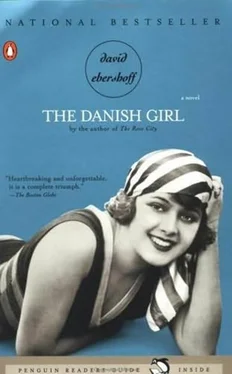Her shrieks were high and glassy and, even Lili knew, sliced through the corridors of the Municipal Women’s Clinic, erupting a pimpling chill on the spines of the nurses and on the skin stretched across the bellies of the pregnant girls. There was an inflamed pain in the lower half of her body. If she’d had the strength, Lili would have lifted her head and looked down to her own middle to see if a bonfire burned there, baking the bones in her pelvis.
She dreamily felt as if she’d risen above her bed and was now looking down: little Lili, her body carved into existence by Professor Bolk, lay strapped beneath the blanket, her arms spread out, the underside of her wrists pale green and exposed. Ropes braided from Italian hemp crossed her legs, sandbags hanging from them, dangling heavily next to the bed. There were four on each side, each bag hooked to a thick rope that ran over Lili’s shins, holding them down against the spasms.
A nurse Lili didn’t recognize ran into the room. She was full-breasted and mustached, and cried, “What can I get you?” She pushed Lili back against the stack of pillows.
It was as if the screaming belonged to someone else. For a moment Lili thought maybe it was Einar who was screaming: perhaps his ghost was rising inside her. It was a terrible thought, and she sank her head into the pillows and sealed her eyes. But she was still screaming-she couldn’t help herself-her lips chapped and crusted in the corner and her tongue a thin dry strip.
“What’s wrong?” the nurse kept asking. She seemed only partially concerned, as if she had seen this before. She was young, with a glass-bead necklace that cut into her throat. Lili looked at the nurse, at the throat so padded with flesh that it nearly hid the necklace, and thought maybe she had seen the nurse before. The line of fine hairs above her lip-that was familiar-and the breasts stretching the bib of her apron. “You mustn’t move,” the nurse was saying. “It’ll only make it worse. Try to be very still.”
The nurse brought a green rubber mask to Lili’s face; out of the corner of her eye Lili could see the nurse turn the nozzle of the tank and release the ether. And this was when Lili realized she had met the nurse before. She had a weak memory of waking herself up by screaming; and then the nurse rushing in, her breasts, caught in the apron’s bib, swinging over Lili as she took Lili’s temperature. There was the readjustment of the ropes across Lili’s shins, and the glass stick of the thermometer slipped beneath her tongue. All this had happened before. Especially the cone of the green rubber mask, which fit snugly over Lili’s mouth and nose, as if one of the factories up the Elbe whose flame-rimmed smoke-stacks belched the black effluvium of poured plastic and rubber had molded it especially for her.
It was several weeks before Lili began to emerge from the pain, but eventually Professor Bolk eliminated the doses of ether. The nurse, whose name was Hannah, unhooked the sandbags, freeing Lili’s legs. They were too thin and blue for her to be able to walk down the corridor, but she could sit up again, for an hour or two each morning, before the daily morphia injection that would sink into her arm with the deep sting of a wasp.
Nurse Hannah would wheel Lili down to the Wintergarten. There she would leave Lili to rest, parking the wheelchair next to a window and a potted fern. It was May, and outside the rhododendrons were puckered and full. Along the wall of Bolk’s laboratory, in the bed of soil and compost, tulips were reaching toward the sun.
On the lawn, with its litter of dandelions, Lili watched the pregnant girls gossip. The sun was bright against their white necks. Since the end of winter, there were new girls. There would always be new girls, Lili thought, sipping her tea, pulling the blanket over her lap, which beneath the blue hospital gown and the pads of gauze and the iodine dressing was open and weepy and raw. Ursula was no longer at the clinic, and this confused Lili. But she was too tired and too softened with drug to consider it further. She had once asked Frau Krebs about Ursula, and she had rearranged Lili’s pillows and said, “Don’t worry about her. Everything is fine now.”
Greta could visit only a few hours each afternoon. A rule, instituted by Professor Bolk and enforced by the metallic voice of Frau Krebs, banned visitors in the mornings and evenings. These were the times when the girls of the clinic were to be alone but together, as if their condition and trouble were a seal of camaraderie that outsiders couldn’t share. And so each day Greta would visit from just after lunch, when Lili’s lip would still hold a spot of potato soup, until late afternoon, when the shadows grew long and Lili’s head would loll into her chest.
Lili looked forward to the sight of Greta entering the glassed-in Wintergarten . Often a large bouquet of flowers-first jonquils, then, as the spring progressed, snapdragons, and finally pink peonies-would hide Greta’s face as she appeared in the door. Lili would wait patiently in her wicker wheelchair, listening to the clack of Greta’s shoes on the tile floor. Often the other girls would whisper about Greta (“Who’s the tall American with the gorgeous long hair?”), and that talk-the airy voices of the girls whose breasts were filling daily with milk-pleased Lili.
“As soon as we get you out of here,” Greta would say, settling into a recliner, her legs up on the long white cushion, “I’m going to take you straight back to Copenhagen and let you have a look around.”
Greta had been promising this since she arrived from Paris: the train and ferry back to Denmark; reopening the apartment in the Widow House, which had remained shuttered for years; a spree in the private dressing room of Fonnesbech’s department store.
“But why can’t we go now?” Lili would ask. Not once in five years had she or Greta returned to Copenhagen. Lili had a vague memory of Einar instructing the shippers, with their sleeves rolled to their elbows, to handle carefully the crate that held his unframed canvases. She remembered watching Greta empty the drawers of the pickled-ash wardrobe into a little trunk with leather hinges that Lili never saw again.
“You’re not quite finished here,” Greta would remind Lili.
“Why not?”
“Only a little more time. Then we can go home.” How pretty Greta was, in her paneled skirt and her high-heel boots, resting next to Lili. Greta had never loved anyone more than her, Lili knew. Now-now that even her government papers claimed she was Lili Elbe-she felt certain Greta wouldn’t change. It was what got Lili through it, through the lonely nights in the hospital room beneath the heavy blanket, through the bouts of pain that sneaked up and mugged her like a thief. Lili was always changing, but not Greta, never Greta.
Professor Bolk would sometimes join Lili and Greta, standing over them, Greta’s legs stretched out on the recliner, Lili in her chair. “Won’t you sit with us?” Greta would ask, repeating her request three or four times, but the professor never stopped long enough to take the cup of tea that Lili always poured for him.
“It seems to be working,” Professor Bolk said one day.
“Why do you say that?” Greta asked.
“Take a look at her. Doesn’t she look well to you?”
“She does, but she’s getting anxious to be done with this,” said Greta, standing to meet Professor Bolk.
“She’s becoming quite a pretty young lady,” he said.
Lili watched them, their legs near her face, making her feel like a child.
“She’s been here over three months,” Greta said. “She’s beginning to think about life outside the clinic. She’s anxious to head out into the-”
“Stop talking about me like I’m not here,” Lili interrupted. It spilled from her mouth, the angry little interruption, as her food had done during the first druggy days after the operations.
Читать дальше












